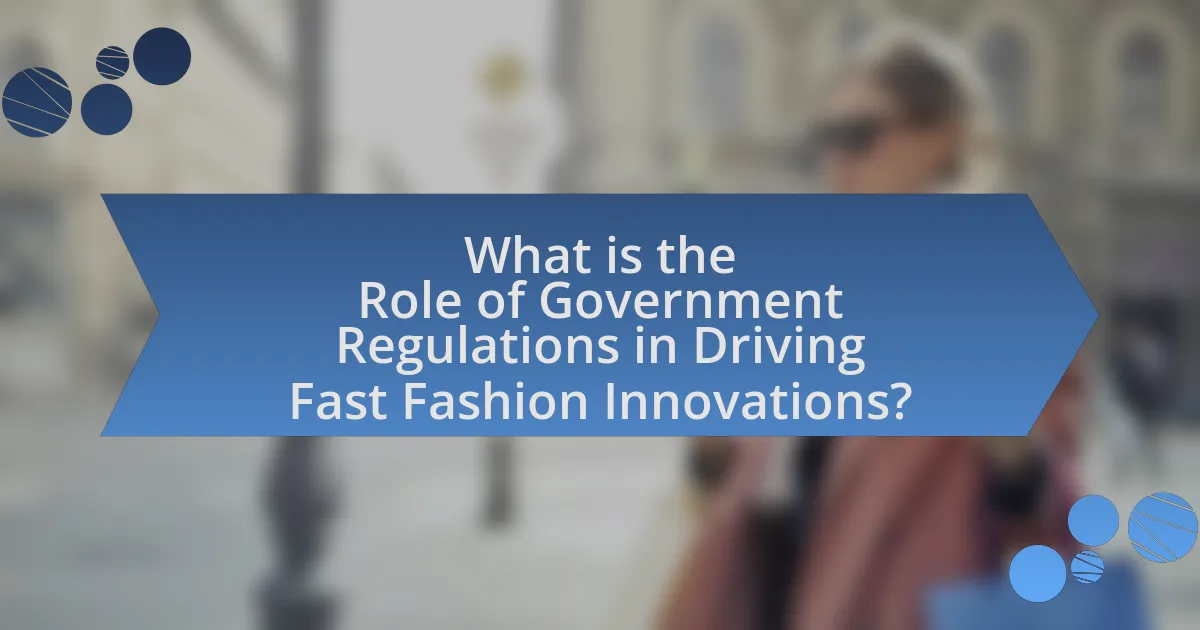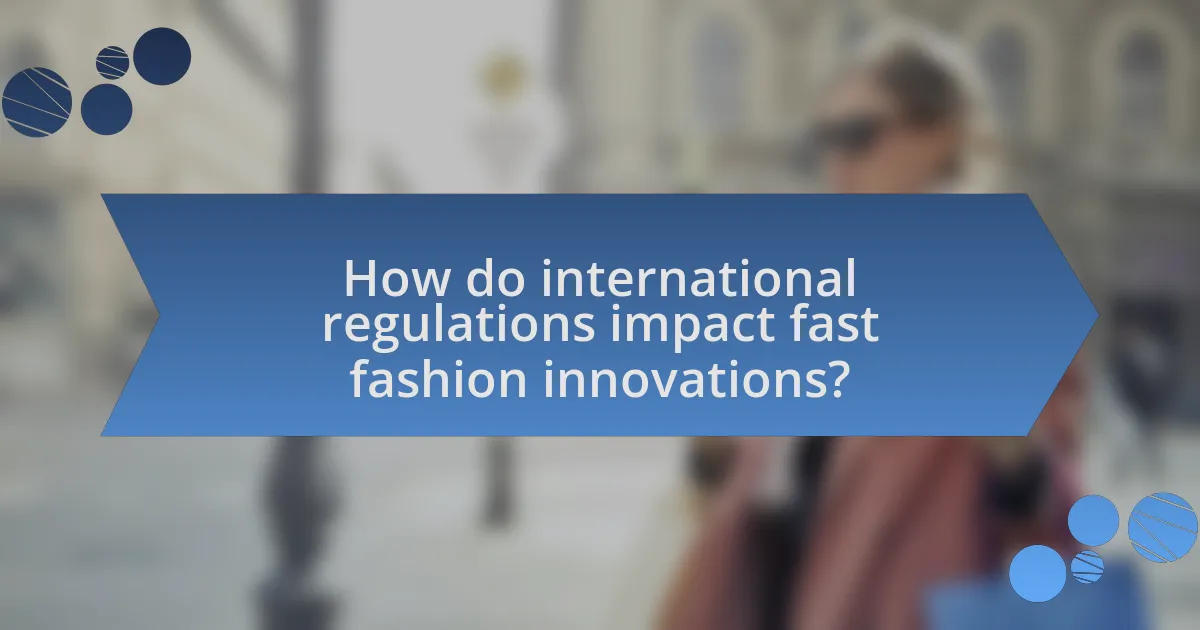The article examines the critical role of government regulations in shaping innovations within the fast fashion industry. It highlights how regulations related to sustainability, labor rights, and consumer safety compel fast fashion brands to adopt more responsible practices, such as improved supply chain transparency and the use of eco-friendly materials. The discussion includes specific regulations impacting the industry, the influence of these regulations on consumer behavior, and the challenges faced by brands in compliance. Additionally, it explores how innovation is driven by regulatory frameworks and the strategies brands can implement to navigate these evolving standards effectively.

What is the Role of Government Regulations in Driving Fast Fashion Innovations?
Government regulations play a crucial role in driving fast fashion innovations by establishing standards that promote sustainability, labor rights, and consumer safety. These regulations compel fast fashion companies to adopt innovative practices to comply with environmental laws, such as the European Union’s Circular Economy Action Plan, which encourages recycling and waste reduction. Additionally, regulations regarding labor practices, like the Fair Labor Standards Act in the United States, push companies to improve working conditions, leading to innovations in supply chain transparency and ethical sourcing. Such regulatory frameworks not only foster competitive advantages for compliant brands but also drive industry-wide shifts towards more sustainable and responsible practices.
How do government regulations influence the fast fashion industry?
Government regulations significantly influence the fast fashion industry by imposing standards that affect production practices, labor conditions, and environmental impact. For instance, regulations regarding labor rights can compel fast fashion brands to improve working conditions and wages for factory workers, as seen in countries like Bangladesh where the government has enacted stricter labor laws following past tragedies. Additionally, environmental regulations, such as those targeting waste management and pollution, can drive fast fashion companies to adopt more sustainable practices, as evidenced by the European Union’s directives aimed at reducing textile waste. These regulations not only shape operational strategies but also impact consumer perceptions and brand reputations, ultimately influencing market dynamics within the fast fashion sector.
What specific regulations impact fast fashion innovations?
Specific regulations impacting fast fashion innovations include environmental regulations, labor laws, and trade policies. Environmental regulations, such as the European Union’s REACH (Registration, Evaluation, Authorisation and Restriction of Chemicals) directive, restrict harmful substances in textiles, prompting brands to innovate in sustainable materials. Labor laws, including the Fair Labor Standards Act in the United States, enforce minimum wage and working conditions, influencing companies to adopt ethical production practices. Trade policies, such as tariffs and import quotas, affect sourcing strategies and supply chain logistics, driving fast fashion brands to innovate in efficiency and cost management. These regulations collectively shape the operational landscape for fast fashion, compelling brands to adapt and innovate in response to compliance requirements.
How do these regulations shape consumer behavior in fast fashion?
Government regulations shape consumer behavior in fast fashion by promoting sustainability and ethical practices, which influence purchasing decisions. For instance, regulations that mandate transparency in supply chains compel brands to disclose their sourcing and labor practices, leading consumers to favor companies that align with their values. A study by the Fashion Institute of Technology found that 66% of consumers are willing to pay more for sustainable brands, indicating that regulatory pressures can shift consumer preferences towards more responsible fashion choices. Additionally, regulations aimed at reducing waste, such as bans on single-use plastics, encourage consumers to seek out brands that prioritize eco-friendly materials and practices, further altering their buying habits.
Why are government regulations essential for fast fashion sustainability?
Government regulations are essential for fast fashion sustainability because they establish standards that promote environmentally friendly practices and ethical labor conditions. These regulations can limit waste, reduce carbon emissions, and ensure fair wages, thereby addressing the negative impacts of fast fashion on the environment and society. For instance, the European Union’s Circular Economy Action Plan aims to make sustainable products the norm, which directly influences fast fashion brands to adopt more sustainable practices. Additionally, regulations like the Modern Slavery Act in the UK compel companies to disclose their supply chain practices, ensuring transparency and accountability. Such measures are crucial for driving the industry towards sustainability and mitigating its adverse effects.
What environmental standards are imposed on fast fashion brands?
Fast fashion brands are subject to various environmental standards aimed at reducing their ecological impact. These standards often include regulations on waste management, water usage, and chemical emissions. For instance, the European Union’s REACH regulation mandates that brands limit the use of hazardous substances in textiles, while the Waste Framework Directive requires proper waste disposal and recycling practices. Additionally, the Global Organic Textile Standard (GOTS) sets criteria for organic fibers and environmentally friendly production processes. Compliance with these standards is essential for brands to operate legally and sustainably in many markets.
How do labor laws affect fast fashion production practices?
Labor laws significantly influence fast fashion production practices by establishing minimum wage standards, working hours, and safety regulations. These laws compel fast fashion companies to ensure fair compensation and safe working conditions for their employees, which can increase production costs. For instance, countries with stringent labor laws, such as those in the European Union, require brands to adhere to regulations that protect workers’ rights, thereby potentially limiting the speed and cost-effectiveness of production. Conversely, in regions with lax labor laws, fast fashion brands may exploit lower labor costs, leading to practices such as long working hours and inadequate safety measures. This dynamic illustrates how labor laws can either promote ethical production practices or enable exploitative conditions in the fast fashion industry.

What are the key innovations in fast fashion driven by government regulations?
Key innovations in fast fashion driven by government regulations include the implementation of sustainable sourcing practices, enhanced transparency in supply chains, and the adoption of eco-friendly materials. These innovations arise from regulations aimed at reducing environmental impact and promoting ethical labor practices. For instance, the European Union’s Circular Economy Action Plan encourages brands to adopt sustainable practices, leading to the increased use of recycled materials and waste reduction strategies. Additionally, regulations mandating supply chain transparency have prompted companies to disclose sourcing information, thereby fostering accountability and ethical labor standards. These regulatory frameworks have significantly influenced the operational strategies of fast fashion brands, pushing them towards more sustainable and responsible practices.
How do regulations promote technological advancements in fast fashion?
Regulations promote technological advancements in fast fashion by establishing standards that encourage innovation and efficiency. For instance, environmental regulations compel companies to adopt sustainable practices, leading to the development of eco-friendly materials and production technologies. The European Union’s REACH regulation, which restricts hazardous substances, has driven brands to invest in safer chemical alternatives, fostering innovation in textile production. Additionally, labor regulations push companies to improve working conditions, prompting the adoption of automation and digital technologies to enhance productivity while ensuring compliance. These regulatory frameworks not only set benchmarks but also incentivize investment in research and development, ultimately advancing the fast fashion industry’s technological landscape.
What role does innovation play in compliance with government standards?
Innovation is crucial for compliance with government standards as it enables organizations to develop new processes, technologies, and products that meet regulatory requirements. By leveraging innovative solutions, companies can enhance efficiency, reduce costs, and ensure adherence to evolving regulations. For instance, the implementation of advanced materials and sustainable practices in fast fashion not only aligns with environmental regulations but also addresses consumer demand for ethical production. This dual benefit illustrates how innovation serves as a strategic tool for compliance, allowing businesses to stay competitive while fulfilling legal obligations.
How are brands leveraging technology to meet regulatory requirements?
Brands are leveraging technology to meet regulatory requirements by implementing advanced data analytics and compliance management systems. These technologies enable brands to monitor and analyze their supply chains in real-time, ensuring adherence to environmental and labor regulations. For instance, companies utilize blockchain technology to enhance transparency and traceability, allowing them to verify compliance with regulations such as the EU’s General Data Protection Regulation (GDPR) and the Modern Slavery Act. Additionally, automated reporting tools streamline the documentation process, reducing the risk of non-compliance and associated penalties. This strategic use of technology not only helps brands fulfill legal obligations but also enhances their reputation and operational efficiency.
What are the challenges faced by fast fashion brands due to regulations?
Fast fashion brands face significant challenges due to regulations that aim to promote sustainability and ethical practices. These regulations often require brands to comply with stricter environmental standards, such as reducing waste and carbon emissions, which can increase production costs. For instance, the European Union’s Green Deal mandates that companies reduce their carbon footprint, compelling fast fashion brands to invest in more sustainable materials and processes. Additionally, labor regulations aimed at ensuring fair wages and safe working conditions can disrupt the low-cost production model that fast fashion relies on, leading to potential supply chain disruptions and increased operational expenses. Compliance with these regulations not only requires financial investment but also necessitates a shift in business practices, which can be challenging for brands accustomed to rapid production cycles and low-cost strategies.
How do compliance costs affect small fast fashion businesses?
Compliance costs significantly impact small fast fashion businesses by increasing their operational expenses and limiting their competitiveness. These costs arise from adhering to various regulations, such as labor laws, environmental standards, and safety requirements. For instance, a study by the International Labour Organization indicates that compliance with labor regulations can increase costs by up to 20% for small enterprises. This financial burden can hinder their ability to invest in innovation and marketing, ultimately affecting their market share and growth potential. Additionally, small fast fashion businesses may struggle to absorb these costs compared to larger competitors, leading to reduced profit margins and potential business closures.
What strategies can brands adopt to navigate regulatory challenges?
Brands can adopt proactive compliance strategies to navigate regulatory challenges effectively. These strategies include conducting regular audits to ensure adherence to regulations, engaging with legal experts to interpret complex laws, and implementing robust training programs for employees on compliance matters. For instance, a study by the International Journal of Fashion Design, Technology and Education highlights that brands that invest in compliance training reduce the risk of regulatory breaches by up to 30%. Additionally, brands can foster open communication with regulatory bodies to stay informed about upcoming changes and participate in industry coalitions that advocate for favorable regulations. This approach not only mitigates risks but also positions brands as responsible market players.

How do international regulations impact fast fashion innovations?
International regulations significantly influence fast fashion innovations by imposing standards that drive sustainability and ethical practices. These regulations often require brands to adopt environmentally friendly materials and processes, which can lead to innovative solutions such as the development of biodegradable fabrics or improved recycling methods. For instance, the European Union’s Circular Economy Action Plan encourages fashion companies to minimize waste and enhance product lifecycle, prompting innovations in design and manufacturing. Additionally, regulations on labor practices compel brands to improve working conditions, which can lead to technological advancements in supply chain transparency and efficiency. Such regulatory frameworks not only shape the operational landscape of fast fashion but also push companies to innovate in ways that align with global sustainability goals.
What are the differences between domestic and international regulations?
Domestic regulations are laws and rules that govern activities within a specific country, while international regulations are agreements and standards that apply across multiple countries. Domestic regulations are tailored to the unique legal, cultural, and economic contexts of a nation, such as labor laws and environmental standards, which can vary significantly from one country to another. In contrast, international regulations, such as those established by organizations like the World Trade Organization or the International Organization for Standardization, aim to create a uniform framework for trade and cooperation among nations, addressing issues like tariffs and product safety standards. The differences highlight how domestic regulations focus on national interests, while international regulations seek to facilitate global interactions and harmonization.
How do trade agreements influence fast fashion practices globally?
Trade agreements significantly influence fast fashion practices globally by facilitating lower tariffs and reducing trade barriers, which enables brands to source materials and manufacture products more cheaply. For instance, the North American Free Trade Agreement (NAFTA) allowed companies to produce garments in countries like Mexico at reduced costs, leading to increased production and faster turnaround times. This access to cheaper labor and materials encourages fast fashion retailers to prioritize rapid production cycles and low prices, ultimately driving the industry’s growth. Additionally, trade agreements often include provisions that promote foreign investment, further incentivizing brands to expand their operations in developing countries, where labor costs are lower, thus perpetuating the fast fashion model on a global scale.
What challenges do brands face when complying with international standards?
Brands face significant challenges when complying with international standards, primarily due to varying regulations across different countries. These challenges include the complexity of understanding and interpreting diverse legal requirements, which can differ substantially in areas such as labor practices, environmental impact, and product safety. For instance, the European Union’s REACH regulation mandates strict chemical safety standards that may not align with regulations in other regions, complicating compliance for brands operating globally. Additionally, the cost of implementing necessary changes to meet these standards can be prohibitive, particularly for smaller brands. According to a report by the International Trade Centre, compliance costs can account for up to 20% of a brand’s total production costs, impacting their competitiveness in the market.
How can fast fashion brands adapt to changing regulations?
Fast fashion brands can adapt to changing regulations by implementing sustainable practices and enhancing transparency in their supply chains. For instance, brands can invest in eco-friendly materials and production processes to comply with environmental regulations, which are increasingly being enforced globally. Additionally, adopting technologies that track and report supply chain practices can help brands meet regulatory requirements regarding labor standards and ethical sourcing. A study by the Ellen MacArthur Foundation highlights that 60% of fast fashion brands are already exploring circular economy models to align with regulatory trends aimed at reducing waste and promoting sustainability.
What best practices can brands implement to stay compliant?
Brands can implement several best practices to stay compliant with government regulations, including conducting regular audits, maintaining transparency in supply chains, and ensuring adherence to labor laws. Regular audits help identify compliance gaps and mitigate risks associated with regulatory violations. Transparency in supply chains allows brands to demonstrate accountability and ethical sourcing, which is increasingly mandated by regulations. Additionally, adherence to labor laws, such as minimum wage and working conditions, is crucial for compliance, as non-compliance can lead to legal penalties and damage to brand reputation. These practices not only ensure compliance but also foster trust with consumers and stakeholders.
How can innovation help brands anticipate future regulatory changes?
Innovation enables brands to anticipate future regulatory changes by fostering adaptive strategies and proactive compliance mechanisms. For instance, brands that invest in sustainable materials and production processes are better positioned to meet emerging environmental regulations, as seen in the European Union’s Green Deal, which aims to make Europe climate-neutral by 2050. By integrating advanced technologies such as AI and data analytics, brands can monitor regulatory trends and consumer preferences, allowing them to adjust their practices ahead of time. This proactive approach not only mitigates risks associated with non-compliance but also enhances brand reputation and market competitiveness.
What practical steps can fast fashion brands take to align with government regulations?
Fast fashion brands can align with government regulations by implementing sustainable practices, ensuring compliance with labor laws, and adopting transparent supply chain management. Sustainable practices include using eco-friendly materials and reducing waste, which aligns with increasing environmental regulations. Compliance with labor laws involves adhering to minimum wage standards and safe working conditions, as mandated by various governments. Transparent supply chain management can be achieved by regularly auditing suppliers and disclosing sourcing practices, which meets regulatory demands for accountability and ethical sourcing. These steps not only fulfill legal requirements but also enhance brand reputation and consumer trust.















